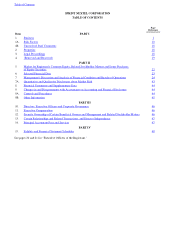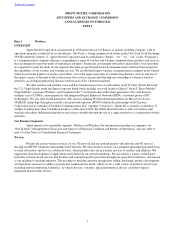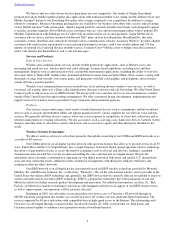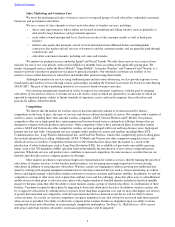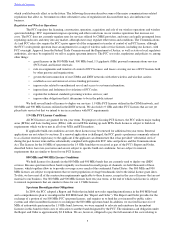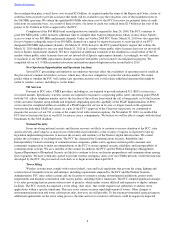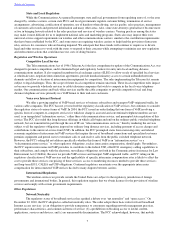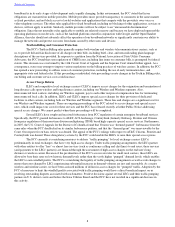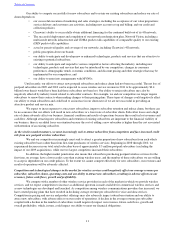Sprint - Nextel 2010 Annual Report Download - page 8
Download and view the complete annual report
Please find page 8 of the 2010 Sprint - Nextel annual report below. You can navigate through the pages in the report by either clicking on the pages listed below, or by using the keyword search tool below to find specific information within the annual report.
the reconfiguration plan, even if those costs exceed $2.8 billion. As required under the terms of the Report and Order, a letter of
credit has been secured to provide assurance that funds will be available to pay the relocation costs of the incumbent users of
the 800 MHz spectrum. We submit the qualified 800 MHz relocation costs to the FCC for review for potential letter of credit
reductions on a periodic basis. As a result of these reviews, our letter of credit was reduced from $2.5 billion at the start of the
project to $1.3 billion in 2010 as approved by the FCC.
Completion of the 800 MHz band reconfiguration was initially required by June 26, 2008. The FCC continues to
grant 800 MHz public safety licensees additional time to complete their band reconfigurations which, in turn, delays Sprint's
access to some of our 800 MHz replacement channels. Under an October 2008 FCC Order, March 31, 2010 was the target date
for us to begin to relinquish some of our 800 MHz channels on a region-by-region basis prior to receiving all of our FCC-
designated 800 MHz replacement channels. On March 31, 2010, however, the FCC granted Sprint's request that it delay the
March 31, 2010 deadline for one year until March 31, 2011 in 21 markets where public safety licensees have not yet moved off
most of Sprint's replacement channels. We have requested an additional extension of the deadline in a small subset of the 21
markets where public safety licensees have not yet moved off of Sprint's replacement channels. Accordingly, we will continue
to transition to our 800 MHz replacement channels consistent with public safety licensees' reconfiguration progress. We
completed all our of 1.9 GHz incumbent relocation and reimbursement obligations in the second half of 2010.
New Spectrum Opportunities and Spectrum Auctions
Several FCC proceedings and initiatives are underway that may affect the availability of spectrum used or useful in
the provision of commercial wireless services, which may allow new competitors to enter the wireless market. We cannot
predict when or whether the FCC will conduct any spectrum auctions or if it will release additional spectrum that might be
useful to wireless carriers, including us, in the future.
911 Services
Pursuant to FCC rules, CMRS providers, including us, are required to provide enhanced 911 (E911) services in a
two-tiered manner. Specifically, wireless carriers are required to transmit to a requesting public safety answering point (PSAP)
both the 911 caller's telephone number and (a) the location of the cell site from which the call is being made, or (b) the location
of the customer's handset using latitude and longitude, depending upon the capability of the PSAP. Implementation of E911
service must be completed within six months of a PSAP request for service in its area, or longer, based on the agreement
between the individual PSAP and carrier. As a part of the FCC's approval of the Clearwire transaction, we committed to
measure the accuracy of our 911 systems at the county level with certain exceptions. On November 29, 2010, we notified the
FCC that we had met the first of our E911 location accuracy commitments. We believe we will be able to comply with the final
benchmark by the 2016 deadline.
National Security
Issues involving national security and disaster recovery are likely to continue to receive attention at the FCC, state
and local levels, and Congress. A major focus of the federal government is cyber security. Congress is expected to take up
legislation implementing measures to increase the security and resiliency of the Nation's digital infrastructure. We cannot
predict the cost impact of such legislation. The FCC has chartered the Communications Security, Reliability and
Interoperability Council consisting of communications companies, public safety agencies and non-profit consumer and
community organizations to make recommendations to the FCC to ensure optimal security, reliability, and interoperability of
communications systems. We are a member of the council. In addition, the FCC and the Federal Emergency Management
Agency/Department of Homeland Security are likely to continue to focus on disaster preparedness and communications among
first responders. We have voluntarily agreed to provide wireless emergency alerts over our CDMA network. Under the time line
developed by the FCC, the provision of such alerts is to begin no later than April 2012.
Tower Siting
Wireless systems must comply with various federal, state and local regulations that govern the siting, lighting and
construction of transmitter towers and antennas, including requirements imposed by the FCC and the Federal Aviation
Administration. FCC rules subject certain cell site locations to extensive zoning, environmental and historic preservation
requirements and mandate consultation with various parties, including Native Americans. The FCC adopted significant changes
to its rules governing historic preservation review of projects, which makes it more difficult and expensive to deploy antenna
facilities. The FCC recently has imposed a tower siting “shot clock” that would require local authorities to address tower
applications within a specific timeframe. This may assist carriers in more rapid deployment of towers. Other changes to
environmental protection and tower construction rules, however, are still possible. To the extent governmental agencies impose
additional requirements on the tower siting process, the time and cost to construct cell towers could be negatively impacted.
Table of Contents
6


